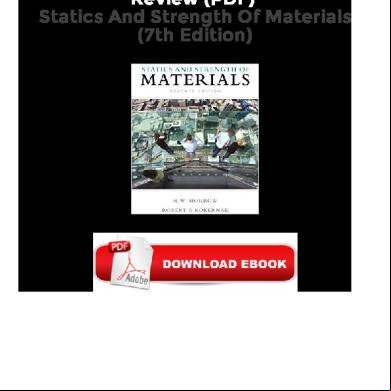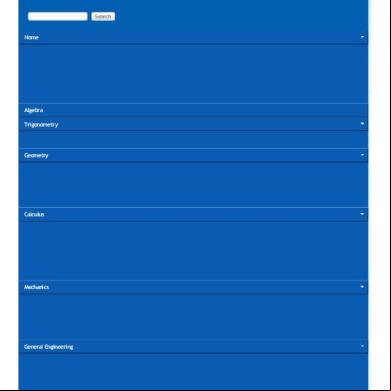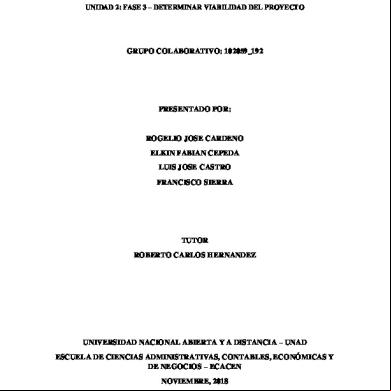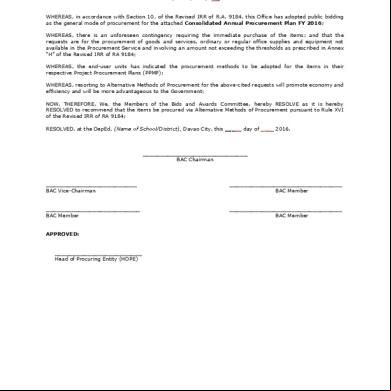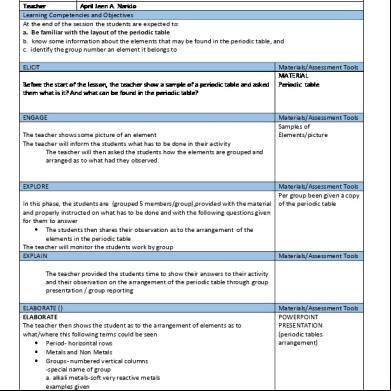Review (pdf) Statics And Strength Of Materials 7th Edition 3l622n
This document was ed by and they confirmed that they have the permission to share it. If you are author or own the copyright of this book, please report to us by using this report form. Report 2z6p3t
Overview 5o1f4z
& View Review (pdf) Statics And Strength Of Materials 7th Edition as PDF for free.
More details 6z3438
- Words: 1,316
- Pages: 5
Review (PDF) Statics And Strength Of Materials (7th Edition)
STATICS AND STRENGTH OF MATERIALS, 7/e is fully updated text and presents logically organized, clear coverage of all major topics in statics and strength of materials, including the latest developments in materials technology and manufacturing/construction techniques. A basic knowledge of algebra and trigonometry are the only mathematical skills it requires, although several optional sections using calculus are provided for instructors teaching in ABET accredited programs. A new introductory section on catastrophic failures shows students why these topics are so important, and 25 full-page, real-life application sidebars demonstrate the relevance of theory. To simplify understanding and promote student interest, the book is profusely illustrated.
Hardcover: 528 pages Publisher: Pearson; 7 edition (January 21, 2010) Language: English ISBN-10: 0135034523 ISBN-13: 978-0135034521 Product Dimensions: 8.6 x 1 x 10.9 inches Shipping Weight: 3 pounds (View shipping rates and policies) Average Customer Review:
3.6 out of 5 stars
23 customer reviews
Best Sellers Rank: #44,394 in Books (See Top 100 in Books) #12 in Books > Science & Math > Physics > Nanostructures #84 in Books > Textbooks > Engineering > Mechanical Engineering #170 in Books > Engineering & Transportation > Engineering > Mechanical
Designed to cover statics and strength of materials at a level not requiring calculus, this leading book has been updated and expanded to include current field data and additional exercises and examples. --This text refers to an out of print or unavailable edition of this title.
Preface The objective of this fourth edition is to cover statics and strength of materials at an elementary level, not requiring calculus. However, for instructors who use the text to teach in accredited programs in the technologies, sections requiring calculus are included. Those sections relate to centroids and moments of inertia of plane areas and deflection of beams by integration. Marked with an asterisk, this material can be omitted without a loss of continuity. Statics and Strength of Materials is written for students enrolled in the industrial technology or engineering
technology curriculum, and in university-level courses for nonengineering majors, such as architecture. It is also useful for self-study and can serve as a reference for courses in materials, materials testing, machine design, and structural design. Several new features appear in this edition, including a list of objectives at the beginning of each chapter to help students identify specific skills they should acquire from the material covered. Appropriate chapter sections include a comprehensive roster of professional organizations (including addresses, telephone numbers, and Web sites) for professors and students who want more information on material properties or recommended practices related to manufacturing and construction. Other sections include procedures for using mathematical technology (graphing calculators, BASIC programs, and software spreadsheets) to facilitate calculations involved in solving simultaneous equations and determining beam deflections. Aside from this additional material, the general plan of the book is unchanged. Care has been taken to present the various topics with clarity in a simple and direct fashion and to avoid information overload. To that end, more than 200 examples illustrate the principles involved. Chapters 1 through 9 provide coverage of statics, while strength of materials is covered in Chapters 10 through 18. The chapters on statics begin with a review of basic mathematics. The graphical method, together with trigonometric formulas and the component method, are employed to solve concurrent force problems. A discussion of the resultant and equilibrium of nonconcurrent forces follows, with special emphasis on the theorem of moments. Then the force analysis of structures and machines and concurrent and nonconcurrent force systems in space is presented. The chapters on statics conclude with friction, centers of gravity, centroids, and moment of inertia of areas. The chapters on strength of materials begin with the study of stress and strain in axially loaded . This is followed by discussions of shear stresses and strains in torsion , bending and deflection of beams, combined stress using Mohr's circle, columns, and structural connections. The text includes more than 900 problems at various levels of difficulty for the student. Both the U.S. customary system of units and the international system of units (SI) are introduced and applied equally in the problems and examples. The majority of material in this book was originally written by H. W. Morrow, who prepared two preliminary editions for use at Nassau (NY) Community College from 1976 to 1979. These were followed by three editions published in 1981, 1993, and 1998 by Prentice Hall. This fourth edition represents a t collaboration between Mr. Morrow and R. P Kokernak of Fitchburg (MA) State College. We would like to thank the following individuals for the information and help they provided for various sections of the fourth edition: Doug Burgin of the Southern Forest Products Association; John Duffy at RANOR Corporation; and Dr. James Kokernak of Rensselaer Polytechnic Institute.
Special thanks to Steve Helba, Editor-in-Chief of the Technology Division at Prentice Hall, without whose direction this edition would not have been possible, and to Associate Editor Michelle Churma, who guided the project through to completion. We would also like to acknowledge the reviewers of this text: Dr. J. G. Huber, Indiana State University, and Martin E. Gordon, Rochester Institute of Technology. s of the text are encouraged to write the authors with suggestions for improvements in future editions. Such material may be sent via e-mail to rkokernak@fsc, or mailed directly to this address: Robert P Kokernak, Department of Industrial Technology, Fitchburg State College, 160 Pearl Street, Fitchburg, MA 01420.H. W. Morrow Ft. Lauderdale, FL R. P. Kokernak Ashburnham, MA --This text refers to an out of print or unavailable edition of this title.
The book is so poorly organized and seems like it was never edited. Answers to questions are often wrong and several time I have come across questions that just direct you to a previously done question. If I wanted a choose your own adventure book I would have just asked my parents to pull out my books from when I was a kid, for free.
Bought this book for my engineering class and the examples inside of the book are great. They are really well explained and give good real world examples. They do a good job showing you how to do the work correctly and how to solve. Glad this book was used for my class.
Fun material. All statics no dynamics. Great Kinematics style Physics book for strength of materials class.
All good
Book was good. And came earlier than expected.
Just what we needed.
Great price, fast shipping!
Just what my husband needed for his class.Thank you so much for this chance to rent it at such a GREAT price!!!
Statics and Strength of Materials (7th Edition) Engineering Mechanics: Statics Plus MasteringEngineering with Pearson eText -- Access Card Package (14th Edition) (Hibbeler, The Engineering Mechanics: Statics & Dynamics Series, 14th Edition) Statics and Strength of Materials for Architecture and Building Construction (4th Edition) Applied Statics and Strength of Materials (6th Edition) Applied Statics and Strength of Materials (5th Edition) Statics and Strength of Materials for Architecture and Building Construction Applied Statics and Strength of Materials Statics and Strength of Materials for Architecture Statics and Strength of Materials: Foundations for Structural Design Statics and Strength of Materials Schaum's Outline of Statics and Strength of Materials (Schaum's) Statics and Mechanics of Materials (5th Edition) Statics and Mechanics of Materials (4th Edition) Statics and Mechanics of Materials (3rd Edition) Statics and Mechanics of Materials (2nd Edition) Statics and Mechanics of Materials Statics and Mechanics of Materials: An Integrated Approach Engineering Materials 3: Materials Failure Analysis: Case Studies and Design Implications (International Series on Materials Science and Technology) (v. 3) The Complete Strength Training Workout Program for Rugby: Increase power, speed, agility, and resistance through strength training and proper nutrition The Complete Strength Training Workout Program for Volleyball: Develop power, speed, agility, and resistance through strength training and proper nutrition
STATICS AND STRENGTH OF MATERIALS, 7/e is fully updated text and presents logically organized, clear coverage of all major topics in statics and strength of materials, including the latest developments in materials technology and manufacturing/construction techniques. A basic knowledge of algebra and trigonometry are the only mathematical skills it requires, although several optional sections using calculus are provided for instructors teaching in ABET accredited programs. A new introductory section on catastrophic failures shows students why these topics are so important, and 25 full-page, real-life application sidebars demonstrate the relevance of theory. To simplify understanding and promote student interest, the book is profusely illustrated.
Hardcover: 528 pages Publisher: Pearson; 7 edition (January 21, 2010) Language: English ISBN-10: 0135034523 ISBN-13: 978-0135034521 Product Dimensions: 8.6 x 1 x 10.9 inches Shipping Weight: 3 pounds (View shipping rates and policies) Average Customer Review:
3.6 out of 5 stars
23 customer reviews
Best Sellers Rank: #44,394 in Books (See Top 100 in Books) #12 in Books > Science & Math > Physics > Nanostructures #84 in Books > Textbooks > Engineering > Mechanical Engineering #170 in Books > Engineering & Transportation > Engineering > Mechanical
Designed to cover statics and strength of materials at a level not requiring calculus, this leading book has been updated and expanded to include current field data and additional exercises and examples. --This text refers to an out of print or unavailable edition of this title.
Preface The objective of this fourth edition is to cover statics and strength of materials at an elementary level, not requiring calculus. However, for instructors who use the text to teach in accredited programs in the technologies, sections requiring calculus are included. Those sections relate to centroids and moments of inertia of plane areas and deflection of beams by integration. Marked with an asterisk, this material can be omitted without a loss of continuity. Statics and Strength of Materials is written for students enrolled in the industrial technology or engineering
technology curriculum, and in university-level courses for nonengineering majors, such as architecture. It is also useful for self-study and can serve as a reference for courses in materials, materials testing, machine design, and structural design. Several new features appear in this edition, including a list of objectives at the beginning of each chapter to help students identify specific skills they should acquire from the material covered. Appropriate chapter sections include a comprehensive roster of professional organizations (including addresses, telephone numbers, and Web sites) for professors and students who want more information on material properties or recommended practices related to manufacturing and construction. Other sections include procedures for using mathematical technology (graphing calculators, BASIC programs, and software spreadsheets) to facilitate calculations involved in solving simultaneous equations and determining beam deflections. Aside from this additional material, the general plan of the book is unchanged. Care has been taken to present the various topics with clarity in a simple and direct fashion and to avoid information overload. To that end, more than 200 examples illustrate the principles involved. Chapters 1 through 9 provide coverage of statics, while strength of materials is covered in Chapters 10 through 18. The chapters on statics begin with a review of basic mathematics. The graphical method, together with trigonometric formulas and the component method, are employed to solve concurrent force problems. A discussion of the resultant and equilibrium of nonconcurrent forces follows, with special emphasis on the theorem of moments. Then the force analysis of structures and machines and concurrent and nonconcurrent force systems in space is presented. The chapters on statics conclude with friction, centers of gravity, centroids, and moment of inertia of areas. The chapters on strength of materials begin with the study of stress and strain in axially loaded . This is followed by discussions of shear stresses and strains in torsion , bending and deflection of beams, combined stress using Mohr's circle, columns, and structural connections. The text includes more than 900 problems at various levels of difficulty for the student. Both the U.S. customary system of units and the international system of units (SI) are introduced and applied equally in the problems and examples. The majority of material in this book was originally written by H. W. Morrow, who prepared two preliminary editions for use at Nassau (NY) Community College from 1976 to 1979. These were followed by three editions published in 1981, 1993, and 1998 by Prentice Hall. This fourth edition represents a t collaboration between Mr. Morrow and R. P Kokernak of Fitchburg (MA) State College. We would like to thank the following individuals for the information and help they provided for various sections of the fourth edition: Doug Burgin of the Southern Forest Products Association; John Duffy at RANOR Corporation; and Dr. James Kokernak of Rensselaer Polytechnic Institute.
Special thanks to Steve Helba, Editor-in-Chief of the Technology Division at Prentice Hall, without whose direction this edition would not have been possible, and to Associate Editor Michelle Churma, who guided the project through to completion. We would also like to acknowledge the reviewers of this text: Dr. J. G. Huber, Indiana State University, and Martin E. Gordon, Rochester Institute of Technology. s of the text are encouraged to write the authors with suggestions for improvements in future editions. Such material may be sent via e-mail to rkokernak@fsc, or mailed directly to this address: Robert P Kokernak, Department of Industrial Technology, Fitchburg State College, 160 Pearl Street, Fitchburg, MA 01420.H. W. Morrow Ft. Lauderdale, FL R. P. Kokernak Ashburnham, MA --This text refers to an out of print or unavailable edition of this title.
The book is so poorly organized and seems like it was never edited. Answers to questions are often wrong and several time I have come across questions that just direct you to a previously done question. If I wanted a choose your own adventure book I would have just asked my parents to pull out my books from when I was a kid, for free.
Bought this book for my engineering class and the examples inside of the book are great. They are really well explained and give good real world examples. They do a good job showing you how to do the work correctly and how to solve. Glad this book was used for my class.
Fun material. All statics no dynamics. Great Kinematics style Physics book for strength of materials class.
All good
Book was good. And came earlier than expected.
Just what we needed.
Great price, fast shipping!
Just what my husband needed for his class.Thank you so much for this chance to rent it at such a GREAT price!!!
Statics and Strength of Materials (7th Edition) Engineering Mechanics: Statics Plus MasteringEngineering with Pearson eText -- Access Card Package (14th Edition) (Hibbeler, The Engineering Mechanics: Statics & Dynamics Series, 14th Edition) Statics and Strength of Materials for Architecture and Building Construction (4th Edition) Applied Statics and Strength of Materials (6th Edition) Applied Statics and Strength of Materials (5th Edition) Statics and Strength of Materials for Architecture and Building Construction Applied Statics and Strength of Materials Statics and Strength of Materials for Architecture Statics and Strength of Materials: Foundations for Structural Design Statics and Strength of Materials Schaum's Outline of Statics and Strength of Materials (Schaum's) Statics and Mechanics of Materials (5th Edition) Statics and Mechanics of Materials (4th Edition) Statics and Mechanics of Materials (3rd Edition) Statics and Mechanics of Materials (2nd Edition) Statics and Mechanics of Materials Statics and Mechanics of Materials: An Integrated Approach Engineering Materials 3: Materials Failure Analysis: Case Studies and Design Implications (International Series on Materials Science and Technology) (v. 3) The Complete Strength Training Workout Program for Rugby: Increase power, speed, agility, and resistance through strength training and proper nutrition The Complete Strength Training Workout Program for Volleyball: Develop power, speed, agility, and resistance through strength training and proper nutrition
